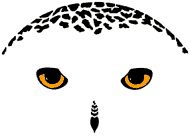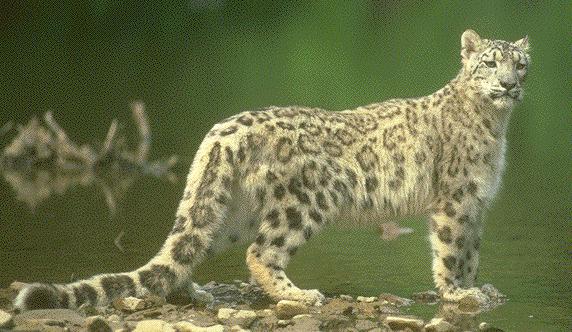

Teachings of
the Snow Leopard
By Ted Andrews

Of all the big cats, leopards are the best at stalking prey. They can remain silent and inconspicuous until they are within only a few feet of their prey then they reveal themselves only for a few seconds at the instant of attack.
Leopards have a strong hunting instinct and intuition, which usually shows up in cubs at an early age. Those with any leopard totem usually have strong intuitive faculties and heightened sensibilities. Leopard cubs learn quickly what is within their ability to capture and how best to approach it. Trusting that inner instinct is part of the life lesson for those with this totem. This can be difficult in developing trust, especially in Western society where we are often taught to ignore the intuitive and only follow the logical. ,
The leopard negotiates its environment in silence. Imitating the walk of the leopard can be a means of helping those with this totem attune to it. The leopard walks with each paw turned inward. The outer edge of the paw will touch the ground first, and thus objects which could cause noise can be avoided before the leopard's full weight comes down on them.
The leopard hunts best at night, and it will often store its prey in a tree. One of the traditional trademarks of the leopard is the tail dangling down. The long graceful tail is often a symbol of sexuality and innate potential.
The snow leopard is found in the high mountains of Asia. This may reflect possible past-life connections to those areas in which it is commonly found. Its green eyes and grayish white coat dappled with rosettes make it one of the most beautiful members of the leopard family. For those with this totem, meditation on its green eyes, the northern direction, and its mountainous and rocky homes may provide insight into its specific role in your life.
Of all leopards, snow leopards are considered the least aggressive. Although many big cats are known to occasionally take human prey, the snow leopard does not do this, even though they are quite capable of taking down prey much larger than themselves. Their environment forces them to be extremely agile and excellent leapers. This hints at its ability to teach those with this totem how to make great leaps over new obstacles in their life.
The snow leopard has been surrounded by mystery and lore. In Central Asia arose a belief that snow leopards do not eat the flesh of their victims, but only suck their blood. Although this probably originated because of the puncture marks cre. ated when the leopard suffocates its prey, it has great symbolism. The blood of anything is its life force. In most societies there existed the belief that what one ate, one became. An animal that only took the blood and not the flesh may indicate great discrimination so that only the powers and life force of the prey is assumed and not its weaknesses (symbolized by the flesh). For those with this totem, it can reflect opportunity to learn how to find the lost life force and drink from it once more, without becoming enmeshed in the old patterns.
There is also an old story of Milarepa, Tibet's poet-saint, who was stranded for six months in the Great Cave of Conquering Demons. When his followers went to find him, they found he had been transformed into a snow leopard. The snow leopard is a totem that can reflect a renewed energy, ability, and opportunity to conquer one's own great demons. Those with this totem would do well to research and meditate upon the life of Milarepa.
The snow leopard lives in the high mountains. Mountains have always been places separate from humans. They were the abodes of gods. They are places of good vista. The animals of mountain gods and goddesses were often sacred to the divine in some way. When a snow leopard reveals itself, it hints of divine protection and a reawakening of one's own spark of divinity.
The snow leopard is solitary and secretive, so for it to be seen is a rare and precious experience—even if only in a vision. The snow leopard has an uncanny ability to blend into the rocky vastness of its environment. Although they have a stocky appearance, due to their thick coat, they are actually slightly smaller than regular leopards, but they are equally good predators. The qualities of the bharal (blue sheep) should also be studied by those with this totem as it is one of its most common prey.
Any questions or comments about this site
-- just click on the envelope in Bluey's hands and he'll deliver your message

Šall orginal material copyright: The Inward Jouney, 1986-1998